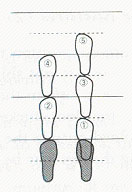Kinhin, commonly referred to simply as walking meditation, is usually practiced in between periods of zazen; the two are considered a set, though either can be practiced alone.
We begin with the feet one fist's width apart at the heel, toes slightly out. Hands are held against the chest: the left hand in a fist with the thumb wrapped inside, the right hand extended flat over the top of the left. As in zazen, the back and neck are straight, eyes at a natural downward angle.

As we inhale, we let our weight shift to the left foot; on the exhalation, the right foot slowly lifts and moves forward one half step so the right heel lands in line with the center of the left foot. At full exhalation, one's weight is equally balanced and the feet are gripping the floor. With the next inhalation, the shift then moves to the right foot, with the movement of the left foot timed to the out-breath. The pace is slow enough that someone glancing into the room may not recognize that we're moving at all.
Kinhin is always practiced in a straight line. Practiced alone, kinhin can follow a one-way or simple round-trip course, but in a group, we usually move in a clockwise rectangle around the room; we make 90-degree turns, stepping with the left foot and bringing the feet together to the starting position, then beginning again with the right. At the sound of the bell, we pick up the pace and return to our cushions.



